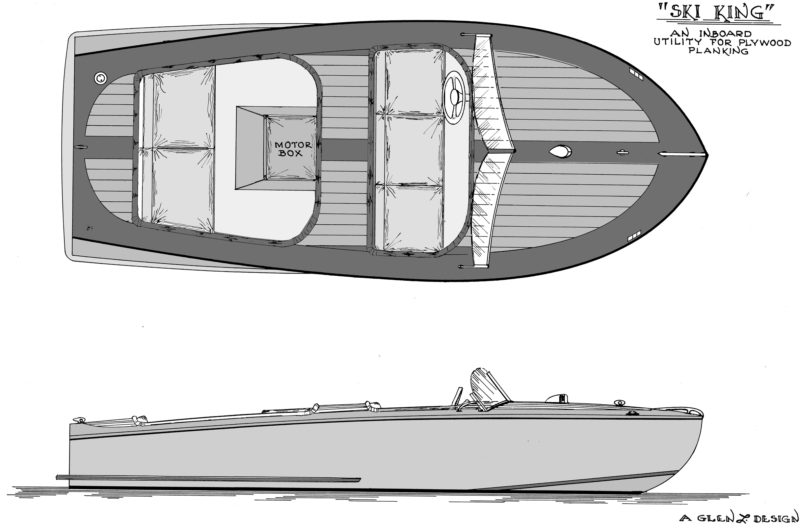The Ski King was designed by company founder Glen L. Witt—a keen water-skier and a boat designer—in 1953, the year he went into business selling plans and kits to home boatbuilders. Although he enjoyed boating in his own 15′ Ski King for many years, at some point sales of the plans diminished and they were removed from the Glen-L catalog. But in 1976, Dwain Colton of Portland, Oregon, was keen to purchase a set of Ski King plans which, luckily, were still stored within the company’s archives. As it turned out, Dwain didn’t complete his Ski King until 2003, but the plans are now in Glen-L’s online catalog and “even made it back into our print catalog, which is something that I don’t remember ever happening before,” said Gayle Brantuk, Witt’s daughter who now runs the company.
In August 2017, Jonathon Clark, a former manager in the construction industry, started a 40-week course at the Boat Building Academy in Lyme-Regis. He decided that he would build a Ski King and ordered a set of plans and instructions from Glen L. He could have gone started making the frames—the comprehensive plans include detailed frame dimensions—but because lofting is required part of the Academy’s curriculum, Jonathon began work by drawing the lines full size.
As the lofting process progressed, Jonathon investigated what engine he would install. The plans recommend engines between 45 and 90 hp, noting “the only limitation on the motor is size.” In the higher horsepower range, only car engines would fit; they would have to be marinized, and Jonathon didn’t want to take on the additional challenge. He looked for as big a marine diesel as he could find, and this led him to a 57-hp, four-in-line, water-cooled Yanmar. He soon discovered that this engine wouldn’t fit in the Ski King as drawn, and so he would have to stretch the hull. The plans say that it’s acceptable to increase the 15′ length by up to 10 percent, to 16′ 6″, by spacing the frames farther apart. Jonathon had more or less completed the lofting at this point, so to stretch the hull to 16′ 6″ he simply extended the stern and added an additional frame.
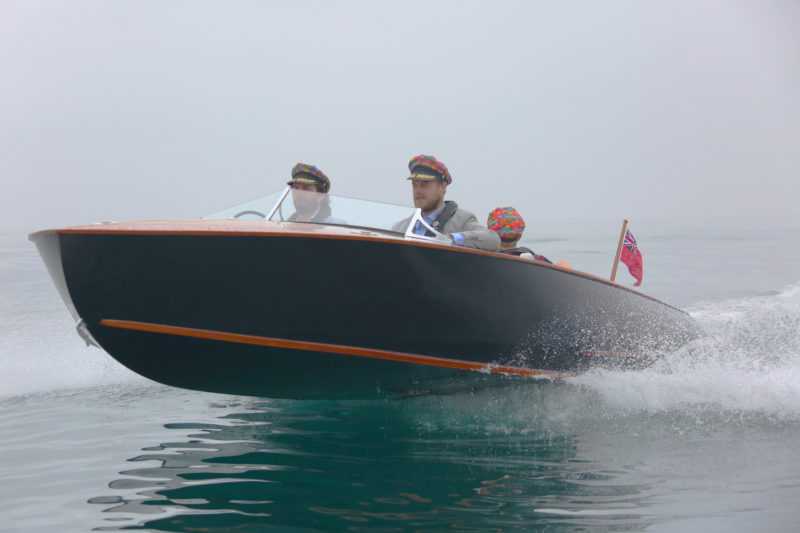
The 57-hp marine diesel installed in AGAPE has enough power to get on plane with a full complement on board.
The hull is constructed upside down, with the motor stringers serving as twin strongbacks supported on temporary uprights and cross cleats. Jonathon and his fellow students would then set the transom and frames in notches cut into the stringers. The plans call for five frames: three of them ring frames, one just a floor, and the forwardmost a ring frame fitted with a plywood bulkhead.
Jonathon ended up fitting seven. He added one frame aft, and another near the bow, which would make it easier to fit the hull planking. The frames were made of 3/4″ thick sapele with 3/8″ plywood laminated to their floor timbers. Jonathon made the transom, originally drawn for 1″ framing and 1/4″ plywood, with 3/4″ ply faced on the outside with 3/32″-thick khaya veneers. The two motor stringers, which are fitted 1′ to either side of the centerline and run from the transom to the bulkhead at station No. 5, are 1″-thick sapele with 3/8″ ply laminated to their outboard faces to keep them from splitting, and they are interlocked into the frames. The stem is made up of two layers of 3/4″ plywood interlocked with the bulkhead at station No. 5 where it is joined to the keelson, which is made up of a laminate of 1-1/8″-thick sapele and 3/8″ ply, again to prevent the splitting that plywood-on-frame construction occasionally suffers. Other longitudinal components—all sapele—include 1″ x 2″ bottom battens, chines laminated in place from two pieces of 5/8″ x 2”, and sheer clamps from two 1/2″ x 2″ pieces, also laminated in place.
Once this framework was completed, the keelson, motor stringers, chines, and sheer clamps were faired to receive the plywood planking.
The plans call for 16’ sheets of plywood, 1/2″ on the bottom and 1/4″ on the sides. That may well have been available in the USA in the 1950s, but Jonathon could only obtain plywood in 8′ lengths. The plans include instructions for using butt blocks to join 8′ sheets to get the full length needed, but Jonathon opted to scarf two sheets to get the length for the bottom. Then, rather than use 1/4″ plywood for the side planking as specified in the plans, he decided that the simplest solution was to cold-mold the curved sides with three diagonal layers of 1/8″ ply.
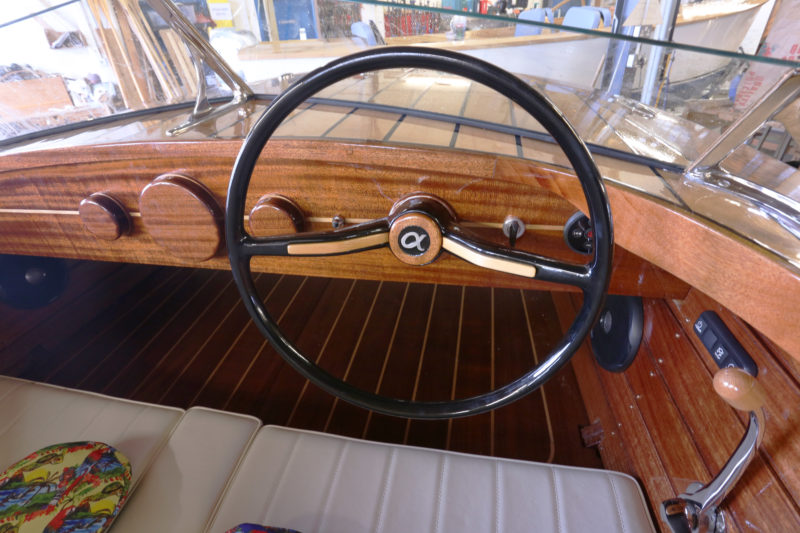
The wheel was originally manufactured for a Volkswagen. The wooden discs are magnetically attached instrument covers that are removed when the boat is in use.
The plans suggest that, as an option, the outside of the hull could be ’glassed for increased durability. In the ’50s that would have meant using polyester resin, but Jonathon used epoxy and one layer of 450-gsm (13.2-oz) biaxial cloth. And while the plans call for Weldwood resorcinol glue, another pre-epoxy standard, epoxy was used throughout the construction, and during assembly everything was held together with a minimum number of bronze screws (far fewer than the plans specified).
Khaya sprayrails were then fitted along the chines, and in the aft part of the boat—where the tumblehome is pronounced—khaya rubbing strakes were fitted along the point of maximum beam. Once the hull was turned over, all the structural components were epoxy-filleted to each other on the inside.
The propeller shaft needed to be angled at 15 degrees, but if the engine was set at that angle, its forward end would be too high. So, it was fitted at an angle of 8 degrees on fabricated stainless-steel engine beds which were bolted to the motor stringers. A 1.47:1 gearbox made up the difference with a down-angle of 7 degrees.
The 14″-diameter, three-bladed bronze propeller came from Michigan Marine. It was supplied with a 12″ pitch, but BT Marine, a company near Lyme-Regis Academy, after examining all the available data, and tweaked the prop to produce a 13.5″ pitch with cupping to give a virtual pitch of 14″. A custom 304 stainless-steel fuel tank with a capacity of 53 liters (14 gallons), which Jonathon hopes will give him a full day’s use without refueling, was installed under the aft deck.
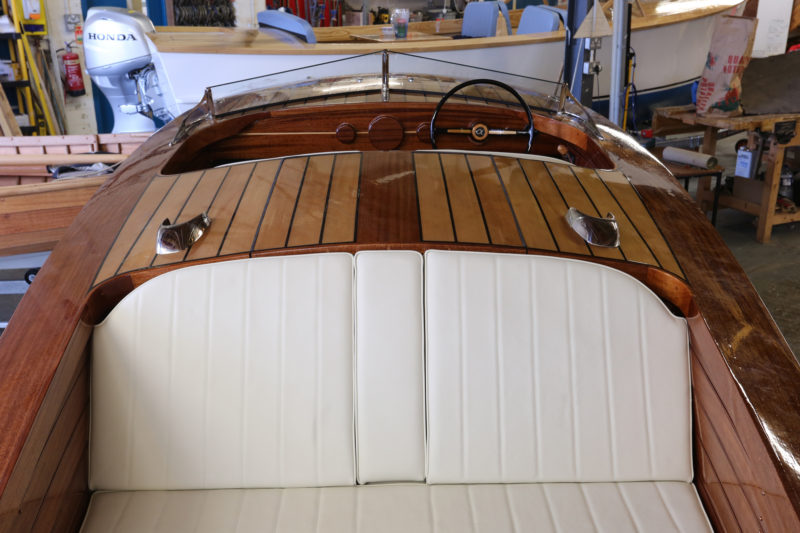 Photographs by the author
Photographs by the authorWhile the plans illustrate a motor enclosure that extends into the aft cockpit, ultimately the layout is determined by the builder and the motor chosen. In AGAPE, the motor is hidden under the deck between cockpits.
Although Glen-L’s plans suggested a narrow bridge deck with an engine box extending aft from it, and a forward-facing seating in the aft cockpit, the details are left to the builder to accommodate the engine chosen. Jonathon felt that a wider bridge deck to completely enclose the engine with aft-facing seating behind it would better suit the 1950s aesthetic and the designer’s intended function for the boat: towing a water-skier.
The top portion of the ring frames serve as deckbeams, and the remainder of the deck structure is sapele. The deck itself is made up of a 1/4″ plywood sub-deck with 1/4″ khaya covering boards and kingplanks, and spruce laid planks. While there is a hatch in the foredeck for access to a stowage locker, Jonathon was keen to avoid obvious hardware such as piano hinges, and the engine hatch will only need to be opened for major servicing or removal, so he has fitted it semi-permanently. Removing the upholstered backrests forward and aft of the engine provides everyday access. Both sets of backrest cushions are in three sections, partly to make them easier to remove and replace, but Jonathon’s attention to detail is well reflected in the fact that the middle sections line up exactly with the kingplank, and the stitching in the outer sections line up with the other deck seams.
Jonathon found it difficult to source suitable chrome and stainless-steel deck hardware in the U.K., but he was able to find much of it in the USA. The windscreen framework came from a 1950s Chris-Craft, and the steering wheel was salvaged from a 1960s Volkswagen Beetle.
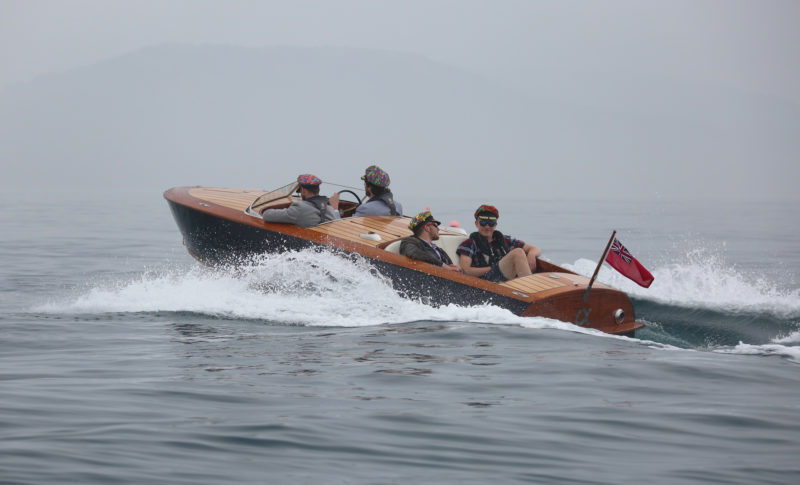
The seats in the aft cockpit face the stern, appropriate for the design’s original purpose of towing water skiers.
The Academy’s launch day, with an enthusiastic crowd looking on, can be a nerve-wracking affair, especially with a high-performance boat such as the Ski King, now christened AGAPE. Initially Jonathon took co-builders Rory Pullman, Arthur Scott, and Sam Stephens, each of whom, along with fellow student Andrew Petter, gave him invaluable support throughout the project. After the inaugural spin around the bay, he returned and invited me to join him.
There was not a breath of wind, and in a very slight swell at close to the full 3,000 rpm, AGAPE got up to 22 knots. Jonathon was delighted: he had expected something like 20 knots with just one person on board. He was reluctant to try turning hard at full speed, but at 17 knots the turning circle was around 20 boat-lengths. Maneuvering at slow speeds was tricky, partly because the engine was set to idle at 800 rpm, a little high, and gave us a minimum speed of just over 4 knots. At that speed the turning circle was about five boat-lengths.
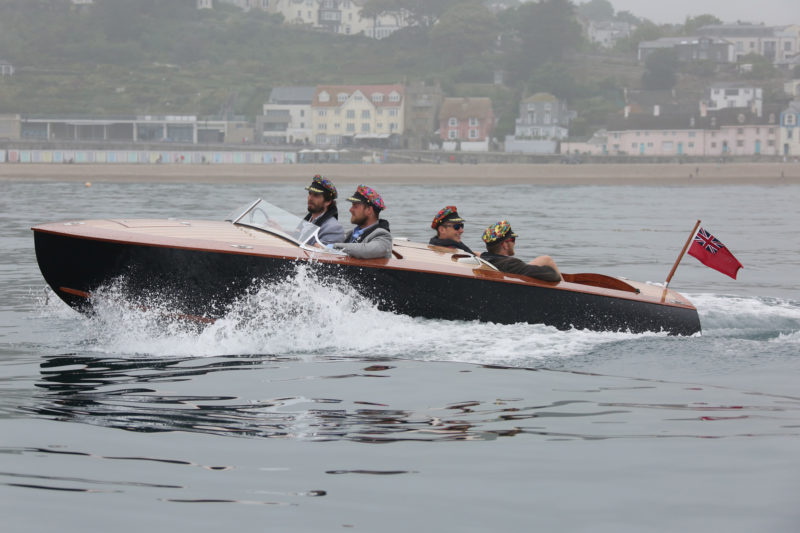
With 54-hp propelling the AGAPE, it is on the low end of the recommended power range. The upper range of 90- to 100-hp would provide a very lively ride.
Jonathon later contacted his engine supplier, Purbeck Marine, and learned this was computer controlled and would settle to about 600 rpm once the engine broke itself in. In reverse, AGAPE is very difficult to steer, but Jonathon accepts that these are typical characteristics of such a boat and hopes that some tweaks will lead to minor improvements.
Sitting in the stern seating area was very comfortable, with less motion than in the driving seat. Even at full speed I was able to write legible notes, and it was possible to have a conversation with my companions above the engine noise. It will be a perfect spot from which to safely keep an eye on a water-skier being towed astern. It was easy to see why Glen L. Witt, who passed away in 2017 at the age of 98, chose to build this one for himself.![]()
Nigel Sharp is a lifelong sailor and a freelance marine writer and photographer. He spent 35 years in managerial roles in the boat building and repair industry and has logged thousands of miles in boats big and small, from dinghies to schooners.
Ski King Particulars
[table]
Length/15′
Waterline length/13′9″
Beam/6′
Hull weight/700 lbs
Average passengers/2 to 4
[/table]
Plans for the Ski King are available from Glen-L for $96.
Is there a boat you’d like to know more about? Have you built one that you think other Small Boats Monthly readers would enjoy? Please email us!

